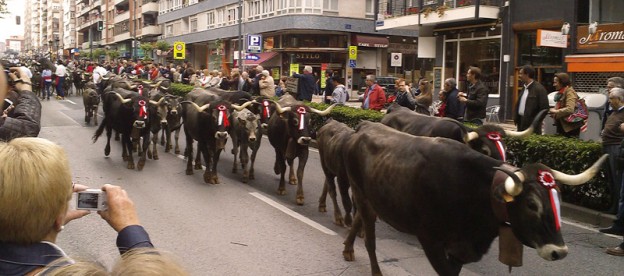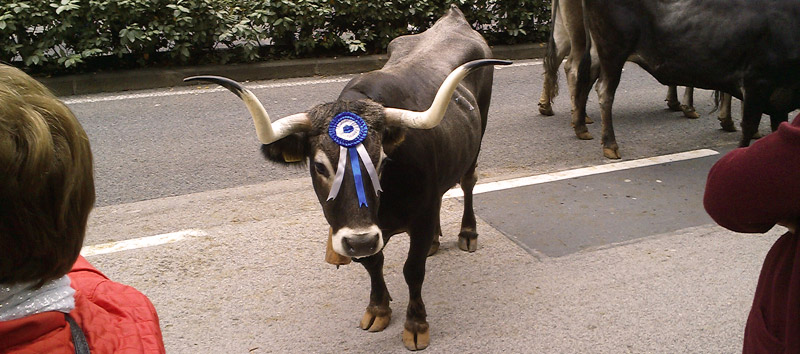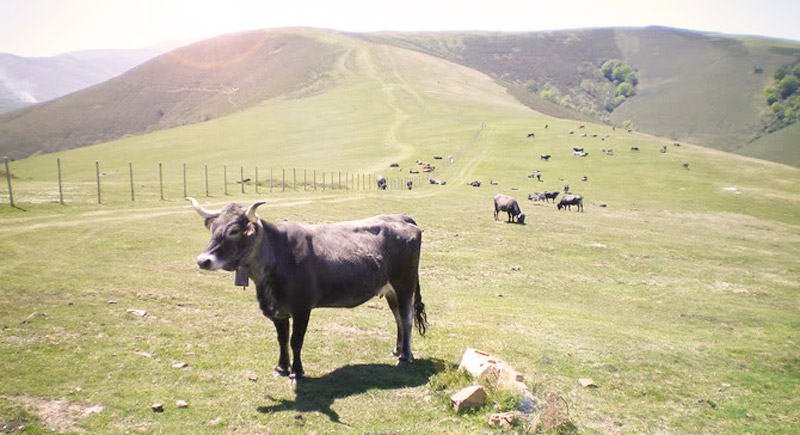
Tudanca cattle parade in Santander
cows
13 de junio de 2014
Last Sunday 1 June, more than 600 Tudanca cows went into Santander’s main streets. Only for a few hours, the city didn’t pay attention to traffic, noise and stress while celebrating the rural identity. Thousands of people crowded the pavement looking out for the cows, which had been dressed with colourful ribbons and rosettes, preceded by sheepdogs and farmers. Unexpectedly, the celebration ended with eight wounded at the hospital when one of the cows, after feeling nervous, left the parade and rushed at the people. Fortunately, nobody was seriously injured.
In my opinion, although the parade had a certain ethnographic and cultural interest -a cow parade or pasá does not go into the streets of a city each day-, it was exaggeratedly advertised on newspapers and press notices as the recovery of the traditional Santander’s pasá. If the very first ones were celebrated between 1984 and 1989, the adjective traditional sounds quite excessive. Anyway, the parade had a strong symbolism for the local citizens, especially for the elderly: in Santander, more than a half of the citizens still keep their family ties and roots in small villages and rural towns of the inner Cantabria, where they have been born and grown up. Besides tourists and other curious people, grandparents taught their grandchildren how the cows and the rural life in which they had grown up were. Inhabitants of the valleys, dressed up with traditional costumes, albarcas, cuévanos and other agricultural tools, preceded the cows waving to their families and friends between the public. In a certain way, the cattle and farmers’ parade through the centre of Santander built up again the sentimental ties between most of the citizens and the towns and valleys from where their families came.

Tudanca cow dressed with a blue and white rosette
The Tudanca cow, which the renowned Spanish thinker and writer José María Cossío described as agile, strong, sober and hardy, is a traditional cattle of the western Cantabria. Although it is completely adapted to the rural environment of the valleys, it is not the most productive cow in terms of dairy or meat. Due to that, it has been displaced during the 20th century by more productive imported cattle, such as Holstein (dairy) or Limousin (meat). Today, there are only around 12.000 animals, about 15% of the animals in 1900: unfortunately, according to the Catálogo Oficial de Razas de Ganado de España (Official Catalogue of Cattle in Spain), the Tudanca cow is endangered. However, this situation is not only related to the Tudanca cow. In Spain, eight out of ten species of regional cattle are endangered.
Nevertheless, the importance of the Tudanca cow is not only genetic and biological. It is also an identity and cultural element of the Cantabria’s inner valleys. Well adapted to the territory, its strength helps it move farm carts loaded with huge amounts of grass along irregular stony paths. In the summertime, it lives free on the fields located at the summits, near the villages, without needing any care. At the end of the summer, the cows are driven back to the winter cowsheds in a parade or pasá which runs along the main street of the villages, where people admire and welcome the cows. The parade ends with a cattle show on the communal land in which the social ties are fortified, new commercial exchanges are built up and, finally, the local society gets stronger.

Tudanca’s territory
The transhumance, the extensive farming system in which the cattle are gathered in winter and freely graze on the mountains in summer, has defined an original use of land in the valleys of Cantabria. The territory has been transformed to boost the farming economy, which has also determined the structure of plots, the architecture and the local network of villages and settlements. Without the Tudanca cow this landscape of the inner Cantabria would be very different.
Undoubtedly, the pasá on 1 June was more cultural than touristic. It would also have been interesting to finish the parade in the Magdalena Peninsula, below the Royal Palace, where the 37th Children’s Day of Cantabria was taking place simultaneously. It could be discussed if it was necessary to have brought the cows from their local valleys to a city in which they are so strange to the sea landscape, or if the security measures were enough but, anyway, the parade helped us discover these endangered cattle, so valuable from an ecological and biological point, and recover the feelings and child memories lived by most of the older citizens. This cultural and social identity is also a memory of the lived landscape, so that it is also a tool to protect, manage or even create our landscapes.
Read more (in Spanish):
CORBERA MILLÁN, M. (2006): «La resistencia de un sistema milenario de trashumancia ganadera de corto recorrido en el valle de Cabuérniga«. Scripta Nova, vol. X, nº 218.
MARTÍNEZ DE PISÓN, E. (2000): “Valores e identidades” en El paisaje: valores e identidades (Martínez de Pisón, E. y Ortega Cantero, N., eds.). Madrid. Universidad Autónoma de Madrid, Fundación Duques de Soria, 11-45.
MARTÍNEZ DE PISÓN, E. (2010): “Saber ver el paisaje”. Estudios Geográficos, Vol. LXXI, no 269, 395- 414
NOGUÉ, J. (ed.) (2007): La construcción social del paisaje. Madrid. Editorial Biblioteca Nueva.
CORBERA MILLÁN, M. (2006): «La resistencia de un sistema milenario de trashumancia ganadera de corto recorrido en el valle de Cabuérniga«. Scripta Nova, vol. X, nº 218.
MARTÍNEZ DE PISÓN, E. (2000): “Valores e identidades” en El paisaje: valores e identidades (Martínez de Pisón, E. y Ortega Cantero, N., eds.). Madrid. Universidad Autónoma de Madrid, Fundación Duques de Soria, 11-45.
MARTÍNEZ DE PISÓN, E. (2010): “Saber ver el paisaje”. Estudios Geográficos, Vol. LXXI, no 269, 395- 414
NOGUÉ, J. (ed.) (2007): La construcción social del paisaje. Madrid. Editorial Biblioteca Nueva.